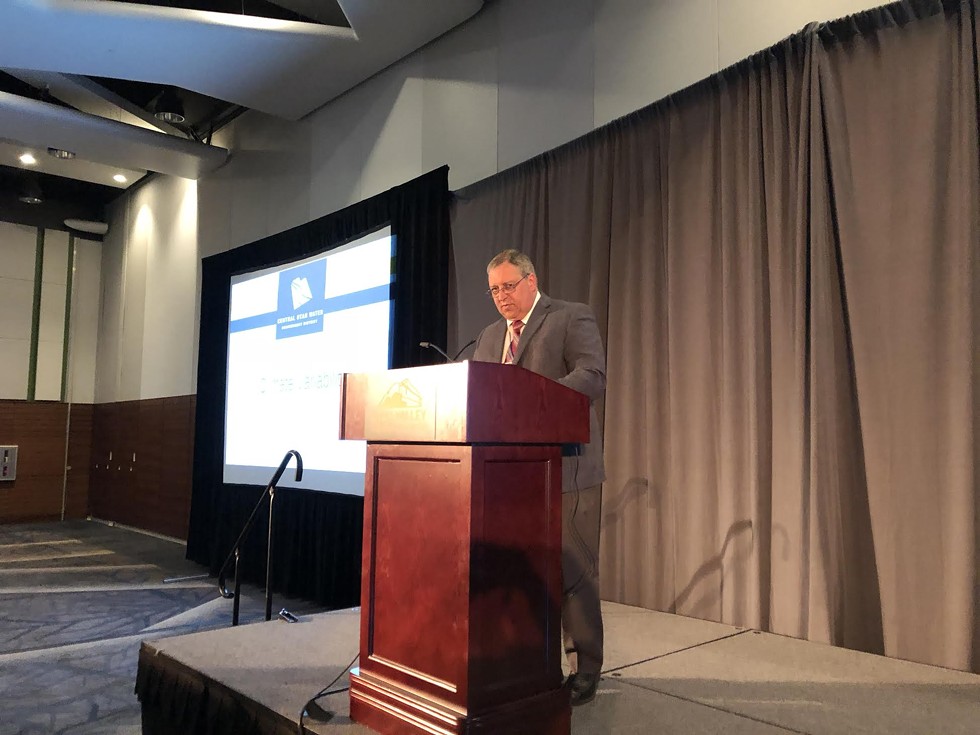Year
Brian McInerney, hydrologist with the National Weather Service in Salt Lake City, had a dire warning for the more than 200 scientists, academics and government workers gathered at the Utah Valley Convention Center on Monday: “We need to think of future generations, instead of political affiliations or nationalism at this point.”
McInerney was one of eight speakers at the Central Utah Water Conservancy District’s second annual Central Utah Water Symposium. Lecturers discussed climate variability and its effects both nation- and statewide. “We hope the main takeaway is, while the topic is complex, there is a lot being done,” Chris Finlinson, assistant general manager with CUWCD, said of the studies and plans being made to provide water to consumers in spite of a drought that has been going on for the “better part of a decade,” save for some wet periods.
“We will always look 50 years into the future,” Tom Bruton, CUWCD assistant general manager, promised the crowd just before the symposium’s end.
Giving a talk titled, “The Fate of Utah’s Snowpack in a Warming Climate,” McInerney projected that between 2035-2065, areas that are 100 percent snow-covered will be about 50 percent or less covered. By the end of the century, McInerney continued, Big and Little Cottonwood Canyons “will probably have snow at the tops of their mountains, the Uintas will have snow, but mostly the rest of the Wasatch Front will be free of snow, and will have rain during the winter time.”
“How we get water right now works really well,” McInerney told City Weekly after his talk: Snow falls in the mountains, then it melts in the springs and flows down channels “that were formed after thousands of years,” filling up a reservoir, “and then we dole it out during the summer months. What happens if it rains periodically, with intense rain events that just run off or evaporate? Our amount of water when it comes to spring will be significantly less.”
“We’re going to leave an environment to our children that is going to be much more difficult for each subsequent generation,” McInerney said.
Currently, more than five million acre-feet of water is sent from the state’s natural water systems to agricultural, residential, commercial, institutional and industrial customers; more than three-quarters of this goes to agricultural use. Utah drinking water comes from the ground—think wells and springs—or surface, meaning rivers and lakes. Symposium speakers predicted that water demands will increase because of warming temperatures and longer growing seasons, while southern Utah’s water supply will diminish; northern Utah will see increased precipitation, but southern Utah will see a decrease; and snowmelt runoff will occur earlier in the year, with lower duration but higher intensity.
Courtney Flint, professor of natural resource sociology at Utah State University, presented the results of a 2014 Utah water survey of 23 neighborhoods in Cache, Heber and Salt Lake valleys: half of respondents said climate change is happening and is mostly caused by human activities; 27 percent said it’s happening but is caused mostly by natural processes; 5 percent said it isn’t happening; and 18 percent said they didn’t know enough to say either way. “We have quite a few folks that are really sitting in the middle on this,” Flint said, noting that belief in climate change varied by whether the community was urban or rural, respondents identified member of The Church of Jesus Christ of Latter-day Saints, as well as sociodemographic status. Seventy percent of respondents said they were concerned about population growth, compared to the 56 percent who said they were worried about climate change and the 63 percent worried about a water shortage.
Warning what could happen if we don’t “get our act together”—stop burning fossil fuels and driving so much, among other economic and lifestyle changes—McInerney told City Weekly that, “we have very little time to turn this around. We’re at the highest CO2 levels since 800,000, possibly to a million years, in the past.
“The way we produce food, the way we live our lives, will be radically different [by about the year 2150],” he said.
As climate change impacts water supply and the state’s population grows, McInerney said, officials might have to look at the 80 to 87 percent of water sent to the agricultural industry. “How are we going to provide water to the municipalities? Most likely it’s going to be taken from the farmers, or we’re going to have to build more reservoirs,” he said. “There’s some hard decisions to be made, and it will be a tough go the farther into this that we go.”


